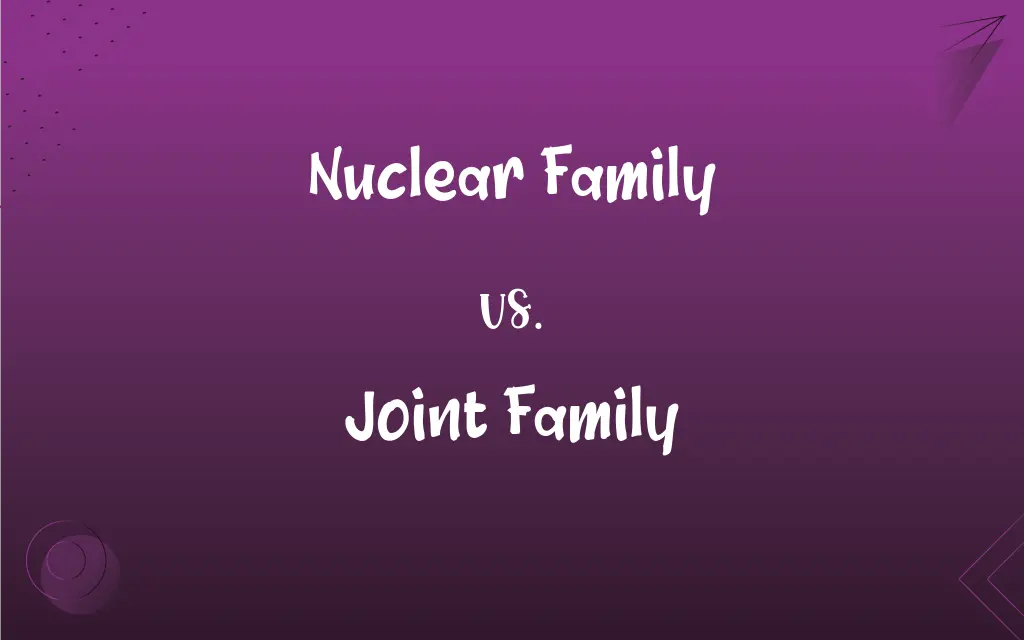Nuclear Family vs. Joint Family: What's the Difference?
By Aimie Carlson & Harlon Moss || Published on November 27, 2023
A nuclear family consists of parents and their children, whereas a joint family includes extended relatives living together.

Key Differences
A nuclear family is traditionally composed of parents and their biological or adopted children. In contrast, a joint family extends beyond this, encompassing multiple generations and relatives living under one roof, sharing resources and responsibilities.
In a nuclear family, decision-making is often more centralized with the parents. A joint family, however, involves more members in decision-making, leading to a collective approach.
The nuclear family model emphasizes individualism and direct parent-child relationships. Conversely, the joint family system fosters a communal lifestyle, blending the roles and influences of various family members.
Financially, a nuclear family is more autonomous, managing its budget independently. In contrast, a joint family often pools resources, leading to shared financial responsibilities and support.
Socially, children in a nuclear family may receive focused attention from parents, while in a joint family, they experience diverse interactions and learnings from multiple family members.
ADVERTISEMENT
Comparison Chart
Size
Typically small, with parents and children
Larger, including extended relatives
Decision-Making
Centralized with parents
Collective involving multiple members
Financial Model
Independent budgeting
Shared resources and responsibilities
Child Upbringing
Direct parent-child interactions
Diverse influences from many relatives
Social Structure
Individualistic approach
Communal living and cooperation
ADVERTISEMENT
Nuclear Family and Joint Family Definitions
Nuclear Family
A nuclear family is characterized by geographical and financial independence from extended family.
The nuclear family moved to a different city for better job opportunities.
Joint Family
In a joint family, resources and responsibilities are pooled among members.
The joint family pooled funds to support the education of all children in the household.
Nuclear Family
A nuclear family involves direct lineage - parents and their offspring.
Family vacations in a nuclear family often involve just the immediate family members.
Joint Family
A joint family is characterized by shared living, with multiple generations under one roof.
The joint family often gathered for meals, with three generations at the table.
Nuclear Family
A nuclear family is the basic unit of a traditional family system.
In many cultures, the nuclear family is seen as the ideal family setup.
Joint Family
A joint family emphasizes communal living and mutual support among relatives.
In times of crisis, the joint family stood together, offering emotional and financial support.
Nuclear Family
A nuclear family is a family unit consisting of parents and their children.
In a nuclear family, decisions about children's education are often made by the parents.
Joint Family
A joint family fosters strong intergenerational bonds and collective decision-making.
Decisions in the joint family were made with input from all adult members.
Nuclear Family
A nuclear family represents a compact family structure.
The nuclear family lived in a small apartment, fitting just the parents and two kids.
Joint Family
A joint family includes a larger group of relatives beyond the immediate family.
In the joint family, cousins grew up together like siblings.
FAQs
How do children's experiences differ in nuclear and joint families?
In nuclear families, children often have more focused parental attention, whereas in joint families, they are influenced by multiple relatives.
What is the size comparison between nuclear and joint families?
Nuclear families are typically smaller, whereas joint families are larger, including multiple generations.
Can nuclear and joint families coexist in the same society?
Yes, both family types can coexist and are often influenced by cultural, economic, and social factors.
How does decision-making differ in these family structures?
In nuclear families, decisions are often made by the parents, while joint families involve collective decision-making.
How does emotional support work in joint families?
In joint families, emotional support is provided collectively, with various members contributing.
What is a nuclear family?
A family consisting of parents and their children.
Are financial responsibilities different in nuclear and joint families?
Yes, nuclear families tend to have independent finances, whereas joint families share financial responsibilities.
How does the child-rearing approach vary between these family types?
Nuclear families focus on direct parent-child upbringing, while joint families offer a more communal approach.
What are the emotional dynamics in nuclear families?
Emotional dynamics in nuclear families are often more intimate and direct.
How do living arrangements differ in nuclear and joint families?
Nuclear families typically live independently, while joint families share a common household.
What are the benefits of a nuclear family setting?
Benefits include independence, focused parenting, and streamlined decision-making.
What defines a joint family?
A family that includes extended relatives living together.
What is the impact of family structure on children’s social skills?
Children in nuclear families may develop strong individualistic skills, while those in joint families often excel in cooperation and sharing.
How are elders integrated into joint family life?
Elders in joint families play a central role in governance, wisdom-sharing, and cultural preservation.
What are common challenges in joint families?
Joint families might struggle with issues like privacy, resource allocation, and collective decision-making.
How does culture influence family structure?
Cultural values and traditions play a significant role in determining whether a society favors nuclear or joint family structures.
What is the typical role of elders in nuclear families?
Elders in nuclear families often have a direct role in childcare and decision-making.
What advantages do joint families offer?
Joint families provide a broad support system, shared responsibilities, and strong family bonds.
How do nuclear and joint families adapt to modern challenges?
Both family types adapt through flexibility, embracing new norms, and adjusting roles to suit contemporary lifestyles.
What challenges do nuclear families face?
Nuclear families may face challenges like limited support systems and intense parental responsibilities.
About Author
Written by
Aimie CarlsonAimie Carlson, holding a master's degree in English literature, is a fervent English language enthusiast. She lends her writing talents to Difference Wiki, a prominent website that specializes in comparisons, offering readers insightful analyses that both captivate and inform.
Co-written by
Harlon MossHarlon is a seasoned quality moderator and accomplished content writer for Difference Wiki. An alumnus of the prestigious University of California, he earned his degree in Computer Science. Leveraging his academic background, Harlon brings a meticulous and informed perspective to his work, ensuring content accuracy and excellence.






































































